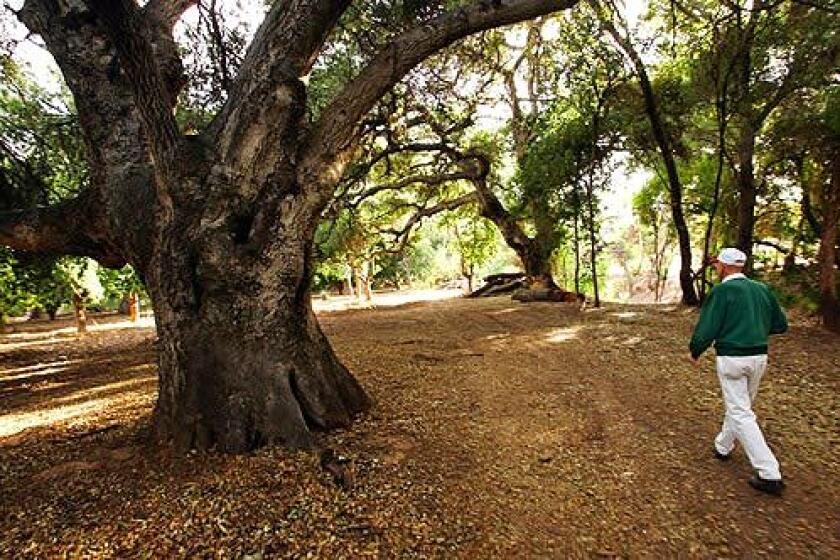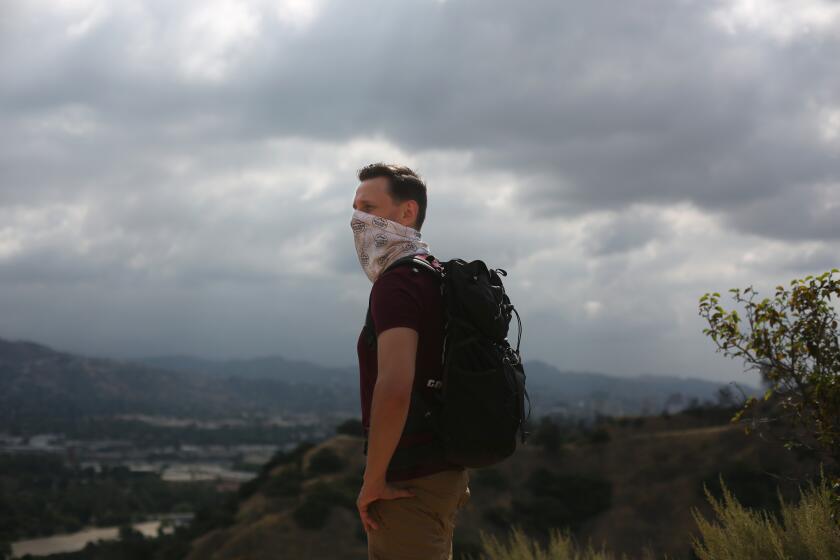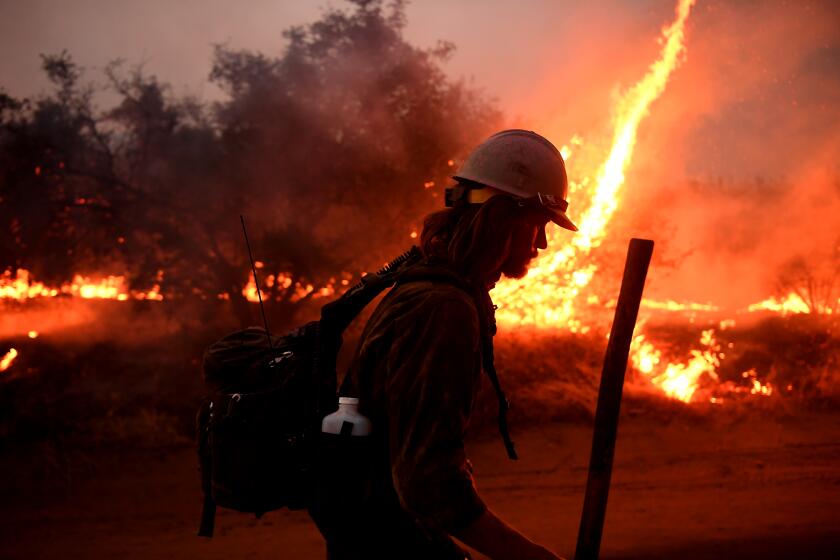As Californiaâs forests burn, an illustrated âfield atlasâ feels like a call to action
If you buy books linked on our site, The Times may earn a commission from Bookshop.org, whose fees support independent bookstores.
As of Sept. 8, 23 active wildfires have burned 1.7 million acres of California forest. Most of them were less than 50% contained and the Santa Ana winds were strengthening. Fire suppression has become a dangerous game of whack-a-mole, a race to choose which fires are worth containing, which to leave alone and which must be abandoned to protect human life. While lightning strikes sparked some of the fires, others have occurred when people have shown little regard for their precarious landscape and climate: high temperatures, drought and wind.
How do we decide what we are willing to protect? How do you make someone care about the things we all need to care about if we are going to survive? If 2020 has imparted any lesson, it may be the sheer difficult of moving people to recognize common obligations. But for naturalist and writer Obi Kaufmann, itâs not an impossible task. There is, he says, âthis almost triangular relationship between love and protection and understanding. People protect what they love, right? People love what they know.â
Kaufmann has written and illustrated âThe Forests of California,â a new âfield atlasâ full of beautiful watercolor renderings of both landscape and data. That pairing of art and science fuses the influences in his life: His mother was a psychologist, while his father was astrophysicist William J. Kaufmann, a past director of the Griffith Observatory. As a teenager, Obi was steeped in his fatherâs math and science but gained something equally valuable on countless hikes up Mt. Diablo: He fell in love with the systems of connection he saw at work all around him.
Books about nature to read while avoiding the coronavirus â from classics by John McPhee and Annie Dillard to the upcoming âBook of Eels.â
To convey what heâd learned, Kaufmann invented a hybrid type of guide: the field atlas. â[It] describes a particular angle on the natural world that is not explained by field guides or road atlases,â Kaufmann tells me on a FaceTime call. âThis book is focused on how big systems in the natural world coalesce to express themselves as they do.â His first such book, âThe California Field Atlas,â was an overview, and he is set to publish six additional field atlases, a project he wryly refers to as a ââGame of Thronesâ of California nature.â âThe State of Waterâ was published in 2019; the series will end with a book on forest fires.
The August wildfires arrived during what felt like the longest summer in recorded time, and the threatened destruction of old-growth redwoods seemed to break a lot of Californians who had been white-knuckling their way through 2020. Then, of course, came September and a new set of devastating fires weâre only just beginning to contend with â already the most acres burned of any year, with the autumn winds just getting started.
âIn the second decade of the twenty-first century,â writes Kaufmann in the new bookâs introduction, âCalifornia weathered six unprecedented ecological and human disasters: two of the largest wildfires, the deadliest wildfire, the most destructive wildfire, the driest and warmest period of drought (2011-2017), and a record rate of tree mortality.â
While panic is a natural reaction to apparent ecological collapse, experience has taught us that it requires a measure of calm and long-term thinking. Kaufmann sees current political rhetoric as amping up the sense that if whole-scale change doesnât happen overnight, all will be lost. Overwhelmed by the task, people give up.
âDiscovering Griffith Park,â a history-rich guidebook by Casey Schreiner, gives one of the countryâs largest, greatest city parks its due.
It is difficult to have a conversation about what is happening to California without what Kaufmann terms âgeographic literacyâ â a notion that gives him a sense of optimism. âFor every point of despair,â he writes, âI have a counterpoint of hope for the survival and restoration of the natural world. ⌠As long as there is time, there is hope.â
Some things have already improved, he points out. In the 1980s, he begins, âBackpacking the Central Coast, I had this acute ache. ⌠There were no otters. There were no condors. There were no whales.â Today, 300 wild pairs of California condors roam their ancestral ranges; humpback whales and sea otters are set to be taken off the endangered species list.
A component of geographic literacy is thinking about a much longer timeline. That was brought home for me earlier this summer when I read âMiracle Country,â Kendra Atleeworkâs memoir about growing up in Swall Meadows, Calif. In 2015, wildfires scorched 7,000 acres and destroyed homes in nearby Bishop. She recounts the devastating impact of the blaze before panning out to examine a centuryâs worth of water-allocation policy that turned a verdant California valley into tinder. These changes took more than one lifetime to happen, leading to the impression that the climate in the Eastern Sierra has been ever thus. It hasnât. And Atleeworkâs documentation of egregious decisions, combined with her own story, drives the point poignantly home. Cleaning up our mess means accepting that we may not live to see the positive effects.
Thinking about deep time helps to put the forest fires in perspective. Consider the recently burned redwoods. The signs are already there that the redwoods will continue to thrive. Kaufmann says that how theyâre built. âCoastal redwood has a plan to live for a few thousand years,â he says. âSo if youâre going to live for a few thousand years, youâre going to encounter a few wildfires. ⌠You have to survive this.â
Intense Diablo winds are forecast for parts of Northern California while Santa Ana winds are expected in Southern California.
Kaufmann argues that, while economics teaches us to think in terms of âabundance or scarcity,â geographic literacy values the connectedness of all living things as a better measure of health.
Thatâs where the forest atlas comes in. Rather than identifying every single variety of tree, Kaufmann focuses on âforest alliances.â For example, the âCoulter pine woodland allianceâ describes groupings of incense cedars, Jeffrey pines, Coulter pines and bigcone Douglas firs all growing in relation to one another. These alliances respond, in turn, to the environment around them.
This level of understanding of what grows where and why â and what changes to expect over time â can foster an appreciation, even a love, for the forest. But even more urgently, it drives home the importance of policies aimed at preserving and protecting the whole system. The project of finding the balance among forest reclamation, replenishment and extraction is work that will carry on for generations.
But what do we do today, as thousands of acres are aflame, threatening both modern homes and an ancient legacy? Kaufmann hears a lot of anxiety among those who ask him such questions at readings â questions intensified by political rhetoric.
âI often answer that question with a question,â he says. âWhen was the last time you went camping? Letâs get you outside to take a couple of days to go to the river, to just enjoy for a moment that this is your place in the universe. Take your shoes off. Put your feet in that river. Take some deep breaths, because whatever happens, weâre going to need you grounded. Weâre going to need you centered and weâre going to need you un-panicked. I think we need that baseline. We need that starting point.â
Berry writes for a number of publications and tweets @BerryFLW.
More to Read
Sign up for our Book Club newsletter
Get the latest news, events and more from the Los Angeles Times Book Club, and help us get L.A. reading and talking.
You may occasionally receive promotional content from the Los Angeles Times.










